Table of contents
- Leather suits and textile suits Crash test in all classes
- Crash test video
- Entry-level textile suit
- Middle-class textile suit
- Upper class textile suit
- Entry-level leather suit
- Middle class leather suit
- Upper class leather one-piece
- Racing leather one-piece
- MOTORCYCLE conclusion
- There were no terrifying examples
- Comparison of the concepts and price regions
- Material dictionary
- Protectors
- This is the new PPE directive
- Interview on the PPE regulation

Photo: Jahn

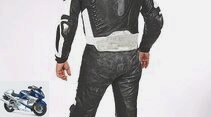
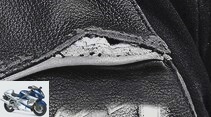

41 pictures
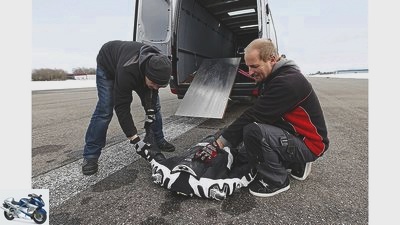
markus-jahn.com
1/41
Mr. Herder, are you finally seeing the black hole? No, Mr. Lohse, but I’ll soon see a yellow glow – my back!
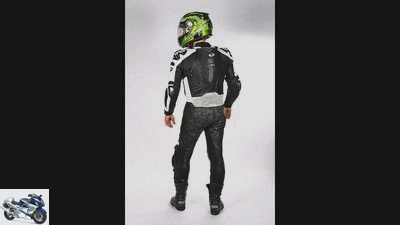
mps photo studio
2/41
Upper class leather one-piece over 1000 euros.
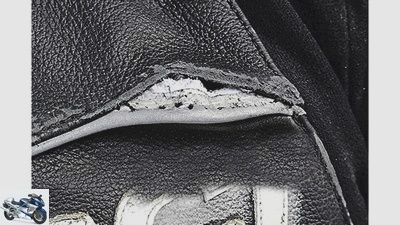
mps photo studio
3/41
Worrying: This seam on the mid-range leather suit also weakens too quickly.

mps photo studio
4/41
On your knees … you never get here! The middle class leather suit has a solidly executed joint.
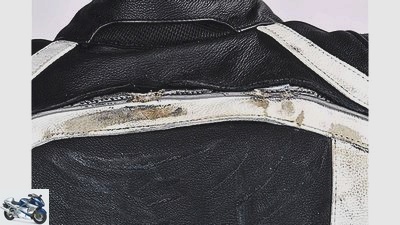
mps photo studio
5/41
In the supine position: predetermined breaking point at an exposed seam in a mid-range leather suit.
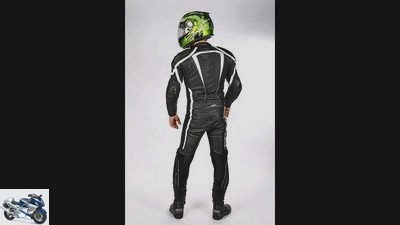
mps photo studio
6/41
Middle class leather suit over 500 euros.

mps photo studio
7/41
Middle class leather suit over 500 euros.
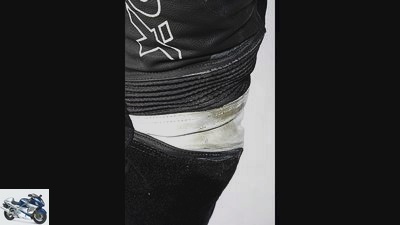
mps photo studio
8/41
Cushioned: Tempo 100 easily puts away the 1.1 mm animal skin of the beginner’s leather suit.
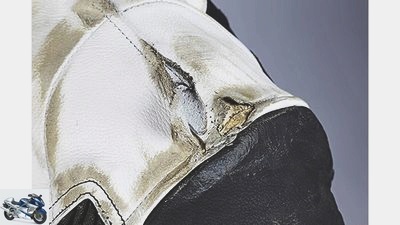
mps photo studio
9/41
Still lasts: thanks to the concealed seams, there is no big break in the entry-level leather suit for less than 300 euros.
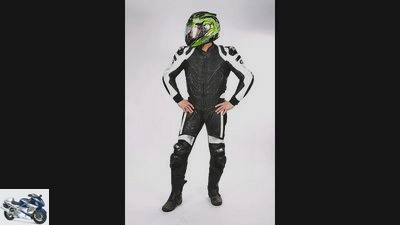
mps photo studio
10/41
Upper class leather one-piece over 1000 euros.
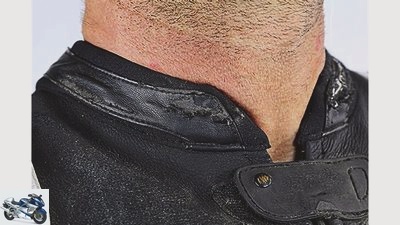
mps photo studio
11/41
The upper-class leather one-piece has perforated leather: good for the climate, no problem in the event of a fall.
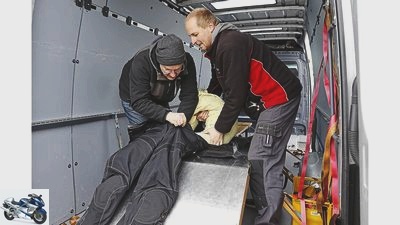
markus-jahn.com
12/41
Touchdown at 100 km / h. It’s good that our Svennie is headless. Otherwise he would make the bend with the second drop.

mps photo studio
13/41
Much more is possible: This is what your knees look like after a heavy braking exercise with a racing leather one-piece.
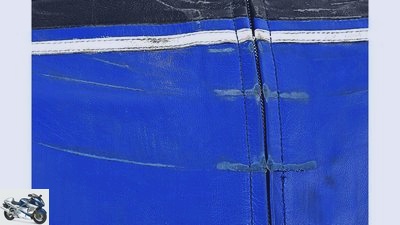
mps photo studio
14/41
Good coverage: The front zipper of the professional leather one-piece has solid protection.

mps photo studio
15/41
Endurance test: With the racing leather one-piece, the leather falls by the wayside, but the seam holds.
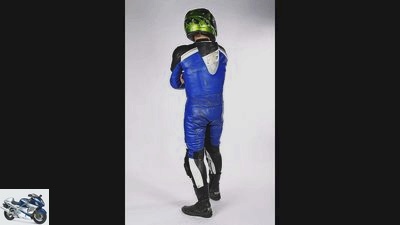
mps photo studio
16/41
Professional / racing leather one-piece for over 1500 euros.
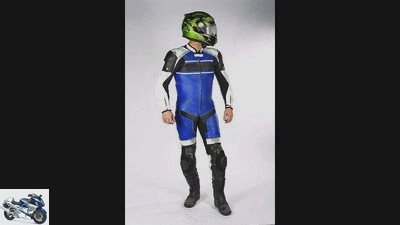
mps photo studio
17/41
Professional / racing leather one-piece for over 1500 euros.
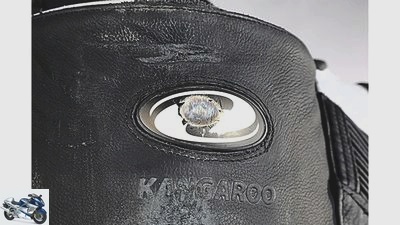
mps photo studio
18/41
Annealed: The titanium insert in the leather divider is evidence of the tough load.
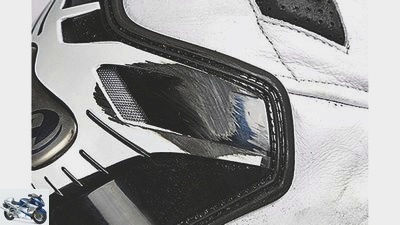
mps photo studio
19/41
Was there something? The joint reinforcements of the upper-class leather one-piece offer a lot of extra protection.
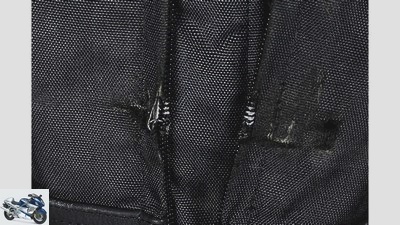
mps photo studio
20/41
The zipper of the beginner’s leather suit for less than 300 euros is poorly protected and is a real predetermined breaking point.
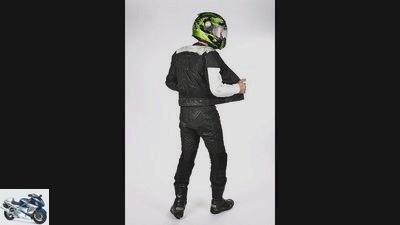
mps photo studio
21/41
Entry-level leather suit for less than 300 euros.
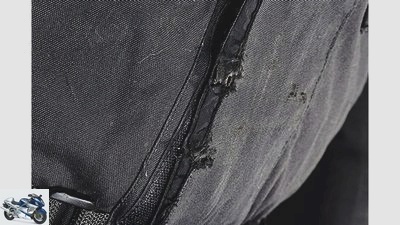
mps photo studio
22/41
Entry-level textile combination for less than 300 euros: In contrast, where Velcro is deposited, the fabric can take a lot.
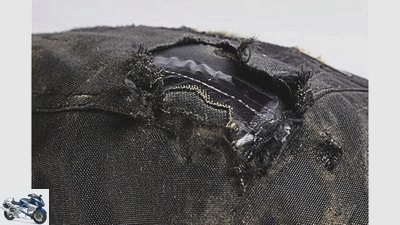
mps photo studio
23/41
The entry-level textile combination opens quickly for less than 300 euros: large holes in neuralgic fall zones.
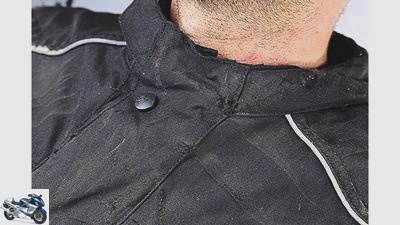
mps photo studio
24/41
The tightly covered front zipper of the entry-level textile suit for less than 300 euros is tight.
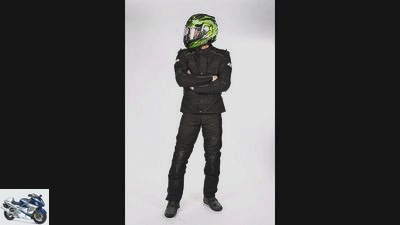
mps photo studio
25/41
Entry-level textile combination for less than 300 euros.
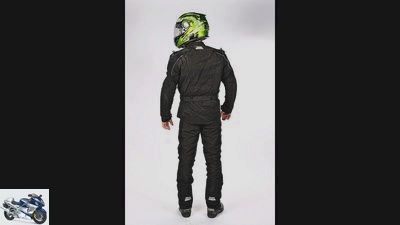
mps photo studio
26/41
Entry-level textile combination for less than 300 euros.
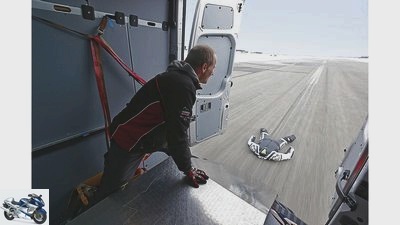
markus-jahn.com
27/41
Touchdown at 100 km / h. It’s good that our self-made dummy Svennie is headless. Otherwise he would make the bend with the second drop.
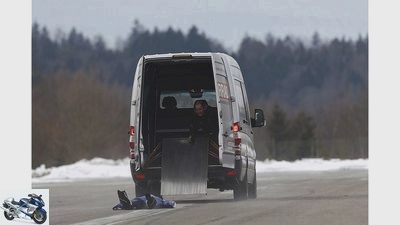
markus-jahn.com
28/41
The sprinter races across the runway at Neuhausen ob Eck airport.
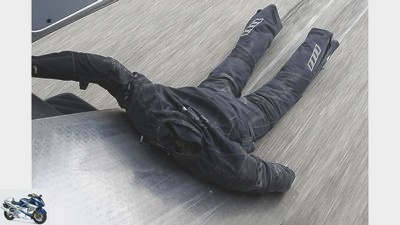
markus-jahn.com
29/41
What is certain? The leather suit or, in the meantime, the high-tech all-weather textile suit?
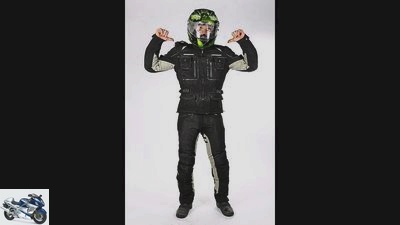
mps photo studio
30/41
Middle-class textile suit for over 500 euros.

mps photo studio
31/41
Middle-class textile suit for over 500 euros.
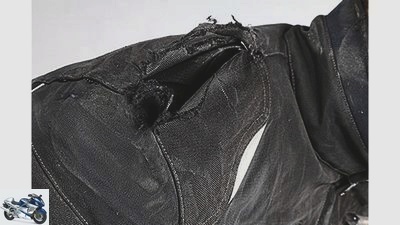
mps photo studio
32/41
Middle-class textile suit for over 500 euros: Despite material reinforcement, not a pleasant look over the shoulder.
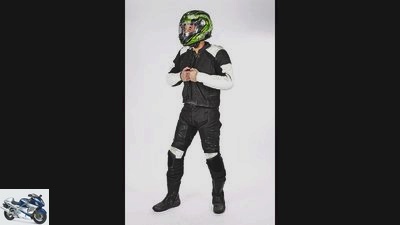
mps photo studio
33/41
Entry-level leather suit for less than 300 euros.
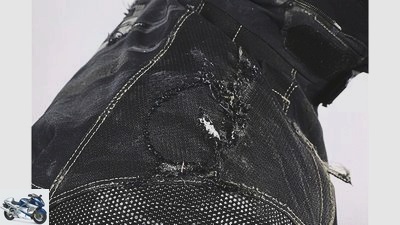
mps photo studio
34/41
Still light with the upper class textile combination: Abrasion, but no hole on the shoulders.

mps photo studio
35/41
Upper-class textile combination for over 1500 euros: Superfabric reinforcements. Besides: less.
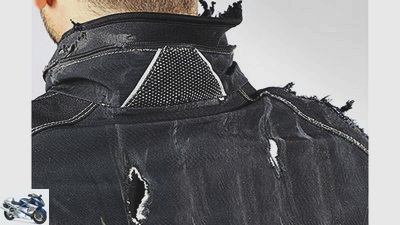
mps photo studio
36/41
In the upper-class textile suit for over 1500 euros you can see the Kevlar-reinforced fabric after the fall.
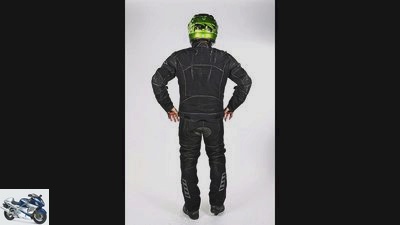
mps photo studio
37/41
Upper class textile suit for over 1500 euros.
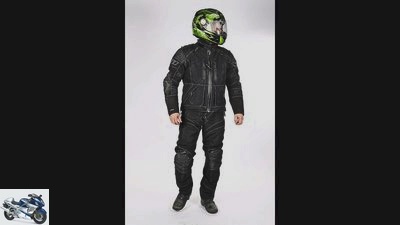
mps photo studio
38/41
Upper-class textile suit for over 1500 euros.

mps photo studio
39/41
Made stable: the mid-range textile suit for over 500 uro has 1000D fabric in the elbows.

mps photo studio
40/41
That was just enough for the mid-range textile suit for over 500 euros: uncovered front zipper.
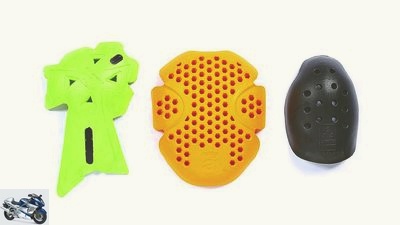
mps photo studio
41/41
CE protectors in three types, three forms, but only for one purpose: They should protect against bad bone fractures in the event of a fall.
clothing
Station wagons, jackets & pants
Leather suits versus textile suits in the crash test
Leather suits and textile suits
Crash test in all classes
Everyone has to endure the crash test: entry-level textile suit, middle-class textile suit, upper-class textile suit, entry-level leather suit, middle-class leather suit, upper-class leather suit and professional leather one-piece suit for the racetrack.
Jorg Lohse
02/29/2016
Our sandman does not have an easy life in the motorcycle combination test. A total of 14 times he rushes down the smooth aluminum ramp from our Sprinter at 100 km / h. Legs first, once on your back and once on your stomach. With the dummy, we want to clarify an old regulars’ table: Which motorcycle clothing is really the best when a “worst case” threatens – take off on the street. The test setup may sound familiar to attentive users. Using Rampe and Sandmann, we also checked the quality of motorcycle jeans.
Crash test video
Subscribe to MOTORCYCLE videos on Youtube
Entry-level textile suit
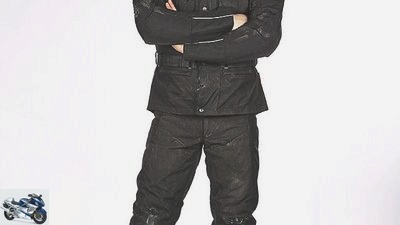
mps photo studio
Entry-level textile suit for less than 300 euros after the MOTORRAD crash test.
Data for sample combination:
- materials: Outer fabric made of polyamide (“Cordura”), lining made of polyester
- Material thickness: 500 denier (D)
- Weight: 2.9 kg (size M)
- Protective equipment: CE protectors in shoulders, elbows and knees, pockets for hip and back protectors (can be retrofitted), with press studs and Velcro, covered zip, short connecting zip, reflective piping and prints
- Others: removable thermal lining
- Country of Manufacture: Vietnam / China
- price: 259.90 euros
Conclusion: The entry-level offer for all-weather riders can cope with a fall from 100 km / h with a bang. Palm-sized holes quickly gape in the polyamide / Cordura mix. The shoulders and knees were particularly affected after the fall simulation. On the plus side: all zips were tight. When it comes to protector equipment, the red pencil rules, the short connection zipper is definitely out of date.
Middle-class textile suit
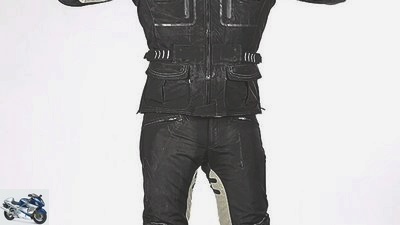
mps photo studio
Middle-class textile suit over 500 euros after the MOTORRAD crash test.
Data for sample combination:
- Materials: outer fabric made of polyamide / polyurethane (“Amidura”), lining made of polyester
- Material thickness: 500/1000 denier (D)
- Weight: 4.7 kg (size 50)
- Protective equipment: CE protectors in shoulders, elbows, hips and knees, pocket for back protector (can be retrofitted), 1000D fabric reinforcements in the fall zones (shoulders, elbows, hips, knees), all-round connection zipper, reflective piping and prints
- Others: removable thermal lining
- Country of Manufacture: Vietnam
- price: 829.98 euros
Conclusion: In the price range between 500 and 1000 euros, the typical equipment list for textile suits is more extensive. And indeed: In our fall simulation, the polyamide fabric, which is reinforced up to 1000D, can withstand the slide on asphalt a little better than the entry-level station wagon. However, not everything is better: the uncovered zipper almost opened. Significant plus points for the protector equipment!
Upper class textile suit
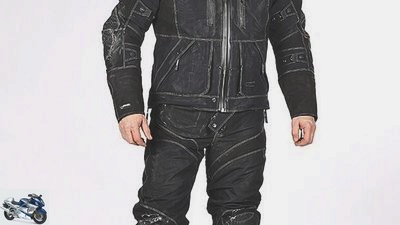
mps photo studio
Upper class textile suit over 1500 euros after the MOTORRAD crash test.
Data for sample combination:
- materials: Outer fabric made of polyamide / PTFE (“Armacor”), lining made of polyester
- Material thickness: 500 denier
- Weight: 5.4 kg (size 50)
- Protective equipment: CE protectors in shoulders, elbows, back, hips and knees, Superfabric and Kevlar fabric reinforcements in the fall zones (shoulders, elbows, knees), all-round connection zipper, seat bridge, reflective prints
- Others: removable thermal lining
- Country of Manufacture: China
- price: 1878 euros
Conclusion: The famous saying “Every chain is as strong as its weakest link” applies above all to the extremely expensive textile combination with so-called Superfabric reinforcements. No question about it, the high-tech fabric is extremely abrasion and tear-resistant. The only problem is that right next to the armor-like panels, the “normal” woven polyamide skin tears almost like paper. The suit wearer now has to carry significantly more than five kilos, but can rely on a full-size protector package for this.
Entry-level leather suit
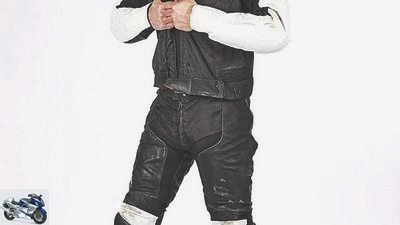
mps photo studio
Entry-level leather suit for less than 300 euros after the MOTORRAD crash test.
Data for sample combination:
- materials: Outer skin made of cowhide with textile inserts made of polyester and stretch inserts made of polyamide, lining made of polyester
- Leather thickness: 1.1 mm
- Weight: 3.6 kg (size 50)
- Protective equipment: CE protectors in shoulders, elbows and knees, pockets for hip and back protectors that can be retrofitted, all-round connection zip
- Others: Knee slider can be retrofitted
- Country of Manufacture: Pakistan
- price: 299.95 euros
Conclusion: At first glance, the large textile inlays in the stomach and legs of this entry-level leather suit, which is available for just under 300 euros, are astonishing. Exciting question: Can it really withstand two falls from 100 km / h in the prone and supine positions? Yes it lasts! Mainly because the textile fibers are built in such a way that they do not play a major role in the slide on asphalt. The leather itself is not really stressed on the 30 meter long slide. The neuralgic point with leather is and will remain the quality of the (hopefully hidden) seams.
Middle class leather suit
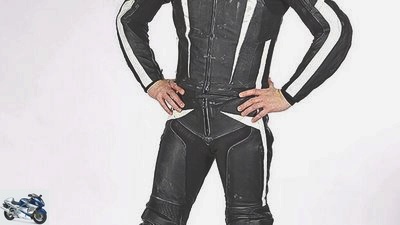
mps photo studio
Middle class leather suit over 500 euros after the MOTORRAD crash test.
Data for sample combination:
- materials: Outer skin made of cowhide, stretch inserts made of polyamide and aramid (“Keprotec”), removable lining made of polyester
- Leather thickness: 1.4 mm
- Weight: 5.0 kg (size 50)
- Protective equipment: CE protectors in shoulders, elbows, back and knees, pocket for hip protectors that can be retrofitted, all-round connection zip, reflective piping
- Others: closable ventilation openings, knee slider can be retrofitted
- Country of Manufacture: China
- price: 749.98 euros
Conclusion: Compared to the entry-level leather, this typical mid-range model does without larger textile additions. For better mobility and fit, however, the arms and legs are provided with high-quality Kevlar stretch, and our leather thickness gauge shows a significantly higher material thickness. Seen in this light, it is not surprising that the leather is quite unimpressed even after hard contact with the asphalt. However, some open wounds show up at the seams.
Upper class leather one-piece
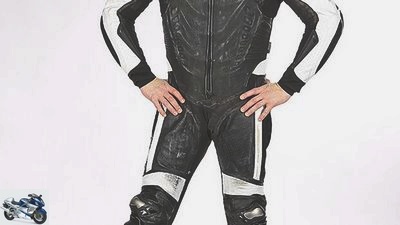
mps photo studio
Upper class leather one-piece over 1000 euros after the MOTORRAD crash test.
Data for sample combination:
- materials: Outer skin made of cowhide, stingray and kangaroo leather, stretch inserts made of leather, polyamide and aramid (“Keprotec”), removable polyester lining
- Leather thickness: 1.2mm
- Weight: 6.0 kg (size 50)
- Protective equipment: CE protectors in the shoulders, elbows, back and knees, soft protectors in the neck, tailbone, hips and ribs, Velcro for retrofittable chest protectors, double leather in the seat area, hard plastic and titanium reinforcements on the shoulders, elbows / forearms and knees
- Others: Knee slider
- Country of Manufacture: Vietnam
- price: 1499 euros
Conclusion: With almost 70 percent kangaroo leather, this semi-professional racing suit goes into the race or quickly comes into contact with the ground. The result? Shake it out, go on. Compared to mid-range leather, all the seams on this suit are set in such a way that they do not cause any problems when falling from 100 km / h. An extensive protector package protects against broken bones.
Racing leather one-piece
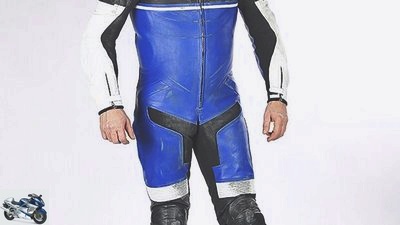
mps photo studio
Professional / racing leather one-piece over 1500 euros after the MOTORRAD crash test.
Data for sample combination:
- materials: Outer skin made of kangaroo leather, stretch inserts made of leather, polyamide and aramid (“Keprotec”), lining made of polyester
- Leather thickness: 1.1 mm
- Weight: 5.1 kg (size 50)
- Protective equipment: CE protectors in shoulders, elbows, back, rump, shins and knees, soft protectors in collarbone, upper arm, ribs and thighs, back humps, nickel silver zippers
- Others: Knee slider
- Country of Manufacture: Germany
- price: 1998 euros
Conclusion: This baggy one-piece racing suit is made with 100 percent kangaroo leather. Tempo 100, departure. Then the critical balance for the front and back: in this case excellent. Small holes adorn the shoulder, but underneath, Kevlar felt and thick foam protectors continue to protect the skin from nasty abrasions. In any case, the protective equipment of the leather suit reads like a textbook in terms of protectors. And with a total weight of around five kilograms, everything is still within limits.
MOTORCYCLE conclusion
The fact remains: when it comes to the best possible protection in the event of a fall on the road, leather continues to have a clear lead. However, predetermined breaking points remain inadequately secured seams. Textile suits still fall behind very quickly in comparison to leather, despite the highly equipped high-tech ingredients. Large holes quickly gape in the tissue, whether it was 260 or almost 1900 euros. In terms of abrasion quality, a 300-euro leather suit is much better off than a textile suit, which is more than six times as expensive.
There were no terrifying examples
The assessment that leather – even in its cheapest version – still has the edge in terms of abrasion? Okay, that’s not really that surprise. All the more interesting, however, is the fact that you have to put a huge amount of (and expensive) additional material in a synthetic suit in order to bring it even approximately to the level of a more or less organically grown suit. The extent to which this is in turn compatible with comfort is a completely different matter. There is no doubt that the Superfabric fabric, which is dipped in epoxy resin, can hardly be impressed by the 30-meter-long slide on the asphalt. However, it is hardly feasible to apply more of these reinforcements to the textile combination. The good piece already weighs well over five kilos – and the motorcycle suit should also be reasonably agile.
The good news: There were no really frightening examples in our cross-comparison of seven suits from different categories. May it be because the manufacturers have already started their homework with regard to the new European directive on “Personal Protective Equipment” (PPE)? And if this will generate further positive impulses in the future (see interview), that is of course more than welcome. Our mute servant Svennie will surely find that too …
Comparison of the concepts and price regions
Since we are comparing apples and pears in this comparison of concepts, this is not about manufacturer names and brands. Rather, we want to know what we can expect in different price regions. In any case, most of what we have procured from well-known clothing suppliers in this country comes from the more or less identical production facilities in Asia. Seen in this way, it doesn’t matter whether the beginner’s outfit made of leather or textile, which costs less than 300 euros, comes from one, the other or even the third shop chain. Or the mid-range station wagon is offered by the X or Y specialist retailer.
It is not indifferent to us how our sand doll looks after the fall simulation from 100 km / h with the different outfits. Of course, in the theoretical preview of our test procedure, a wide variety of theses are put forward. For example, that a leather two-piece from Asia that costs 300 euros cannot even come close to holding a candle to the German racing one-piece made of finely tanned kangaroo skin. Or that the 1000 euros surcharge for a luxury textile suit compared to the mid-range model can be measured in the correspondingly smaller hole size. The truth then lies on the asphalt every half hour. Whir, purr, look. In the course of the day we lose our elasticity due to the constant lifting and balancing, just like our Sven, but the exciting gain in knowledge keeps us on our toes.
Material dictionary
A material dictionary was quickly googled by now. In this overview, however, we want to put together a few basics, facts and comparisons so that you are not struck by the bombastic sounding jargon on jackets and pants labels on your next shopping trip.
leather: The standard combination is still made of cowhide, kangaroo is mostly only used in higher price regions (from 1000 euros) – and even then it is far from being used across the board. It usually starts at 30 to 40 percent. Only in the high-end sector beyond 1500 euros can you find pure kangaroo leather suits. What is the main difference between cowhide and kangaroo leather? Basically, the fiber structure of kangaroo leather is more closely interwoven or interwoven and interlocked. This remains the case even with intensive use – whereas the fiber structure of cowhide increasingly loosens with use. With a lower thickness (1.0 to 1.1 mm) compared to cowhide leather (1.3 to 1.5 mm), better abrasion values can be achieved with lower weight at the same time. At the same time, kangaroo leather does not have the property, like cattle hide, that it becomes hard and brittle or shrinks due to the effects of moisture and sweat. Due to the artificially applied embossing (a mechanical process in the so-called dressing of the leather), it is difficult even for experts to clearly distinguish cowhide and kangaroo leather from one another after finishing, including varnishing.
Textile: Around three quarters of all motorcycle suits sold in Germany are now made of pure synthetic fibers. You should know these basic terms:
polyamide is usually used as a fabric for the outer skin. Polyamide has the property of hardly absorbing water and of being abrasion and tear-resistant. Another form is nylon, which is made from a continuous polyamide fiber. The problem with polyamide: The comparatively low melting point of 250 degrees Celsius can be reached quickly due to the frictional energy when a motorcycle falls.
Cordura is a special variant of polyamide and is sold under this brand name by the chemical company Invista (originally DuPont). The fabric made of cut and spun fibers is even more resistant to abrasion than conventional polyamide or nylon. The sticking point here, too, is the continued low melting point.
polyester is very similar to polyamide in terms of its intended use, but is less tear-resistant and heavier. Mostly the universal fabric for interior decoration (thermal / lining materials).
denier is abbreviated with D and denotes the thread weight per 9000 meters of length in grams. In the motorcycle sector, 500D is the standard, 1000D is mostly used as reinforcement (which means that a 9000 meter long thread was made from 500 or 1000 grams of raw material).
Aramid is the indispensable synthetic fiber to make the fabric with a melting point of 370 degrees high temperature resistant. However, UV resistance is problematic. Aramid is the basis for branded yarns / fabrics such as Kevlar, Armacor or Keprotec.
Protectors
Leather and textile should protect against nasty abrasions in the event of a fall, only well-fitting protectors can help against broken bones. Mind you, the emphasis is on “sitting well”. After all, what use is the best protector if, God knows where, when it hits the asphalt, it slaps around, just doesn’t grip the joint properly and absorbs the impact energy accordingly.
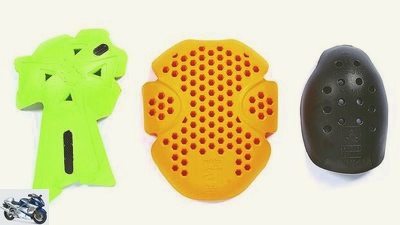
mps photo studio
It’s under the second skin.
Basically, when shopping, you should first make sure that correctly certified protectors are in the appropriate pockets. Usually a label informs about whether the crash pads also comply with the correct standard (EN 1621-1 for joints, EN 1621-2 for the back). Our seven case studies show that in the lower price ranges, only basic protection is usually used for shoulders, elbows and knees. For the hips and back, many providers only use an alibi pillow, which does nothing in the event of a fall. Of course, full protection is already available – only that then costs the corresponding surcharge. If you are not sure, you can actually dig the protector out of your pocket (which you should do to wash your equipment anyway) and look at the label. Certified parts must be marked with the appropriate standard, but the protective sizes should also match your own clothing size. Rule of thumb: With joint protectors, the letter A usually fits children and (small) women sizes, from men size M or 50, the letter B should be visible.
The size of back protectors is specified using the shoulder-to-hip distance. If you value a perfectly fitting seat, you should take the time to determine your own size before buying. This is also a good exercise to see whether the salesperson is on their toes and understands something about the subject.
The limit value of 35 kilonewtons (kN) has been in force in the drop test of joint protectors for almost 20 years. More residual strength is not allowed on average. Following the revision of the European standard EN 1621-1, there is now a second, stricter protection level of 20 kN. The state of the art is now much more advanced.
This is the new PPE directive
First of all, the most important information: No, there will be no obligation to wear standardized motorcycle clothing. The PPE directive 89/868 / EEC, which is currently being revised in the European institutions, primarily serves to make protective clothing recognizable as such. In other words: Consumers can clearly see (e.g. through the logo here on the left) whether the textile or leather suit, glove or boot also meets the clearly defined protection requirements for motorcycling. This standard has existed for a long time for professional motorcyclists, and in the course of the revision it should now also be applicable for normal cyclists.
Interview on the PPE regulation
Mirjam Messerschmidt (41) is responsible for the certification of in-house motorcycle clothing at Detlev Louis.
Europe is now serious about the protective clothing standard for motorcyclists. What’s behind it?
It is correct that the new version of the regulation for “Personal Protective Equipment”, or PPE for short, should be adopted soon. The changes have also become necessary because of difficulties in implementing some points in practice. In addition, the regulations are now to be made clearer and clearer.
We’ll soon all be driving around in uniform knight armor?
Since experts from all areas, from industry to consumer protection, have worked on the new version, it will hopefully be easier to implement and give us developers the necessary leeway. After all, the clothing must be able to be worn in the cold, rainy north as well as in the warm, sunny south of Europe. And all two-wheelers – from scooter riders to motorcyclists – have to be equipped. One must not forget that “knight armor”, which can provide all-round protection against injuries in the event of a fall, may also have unacceptable disadvantages: I am thinking of the restriction of freedom of movement, the rapid fatigue due to heavy weight or the risk of overheating.
A casual retro jacket can also be designed in accordance with standards?
In my opinion, the diversity of motorcycle clothing will be preserved. However, there will be some products that need to be improved or improved. Some materials and constructions that are not stable enough will also disappear from the market.
What are the heaviest chunks that now have to be lifted when developing new items of clothing?
For product development, this means above all more time and costs. The materials and constructions must be checked and confirmed by the certification institutes. Likewise, the entire piece of clothing. Production cannot start before that. After the standard has been published, it will take some time before the changeover to the new requirements is implemented.
In the meantime, all-round protection through protectors or airbags are no longer a dream of the future. What do you think motorcyclist equipment will look like in ten or 15 years?
For the future, I expect new, more durable, but also light materials that make motorcycle clothing more comfortable and convenient. Just as the current trend in protectors is towards light and flexible materials. The airbag will firmly establish itself and find its way into many areas. In my opinion, other shapes, for example in the form of a leg airbag, are also conceivable.
Related articles
-
6 upper-class textile suits in the 4000 km test
Gargolov 24 pictures markus-jahn.com 1/24 The perfect conditions for testing the driver’s equipment as well … mps photo studio 2/24 Ixs Saragossa /…
-
Jahn 11 pictures Jahn 1/11 What to wear for the discovery tour over gravel and asphalt in sun, wind and rain? mps photo studio 2/11 Minimal versus…
-
Nine classic driver’s suits made of cowhide in the test, plus care tips for your leather suits
Lohse clothing Station wagons, jackets & pants Nine classic driver’s suits made of cowhide in the test, plus care tips for your leather suits Product…
-
clothing Station wagons, jackets & pants Comparison test leather suits Comparison test leather suits What’s the point of kangaroo leather? Kangaroo…
-
Test leather suits: leather one-piece from 600 to 800 euros
archive clothing Station wagons, jackets & pants Test leather suits: leather one-piece from 600 to 800 euros Leather suits in the test Test: leather…
-
Product test: long-distance travel textile suits
Herder clothing Station wagons, jackets & pants Product test: long-distance travel textile suits Product test: long-distance travel textile suits…
-
All-weather motorcycle textile suits in the test
mps photo studio 23 pictures mps photo studio 1/23 Evolution in joint protectors: Bering (above) with a small protective surface and weak damping; easy…
-
10 all-weather textile suits up to 750 euros in the test
Dentges 36 pictures mps photo studio, fotolia 1/36 Without an all-weather climate membrane, no textile combination supplier dares to go out on the…
-
Comparative test of textile suits 2012
Jahn clothing Station wagons, jackets & pants Comparative test of textile suits 2012 Product test: upper-class textile suits in comparison The top ten…
-
Two-piece leather suits in the test
Long clothing Station wagons, jackets & pants Two-piece leather suits in the test Product test: two-piece leather suits Leather suits from 600 euros in…